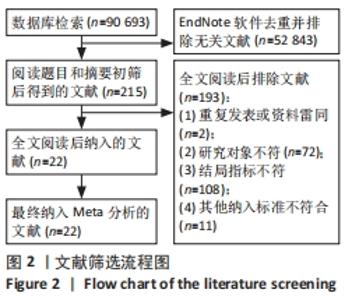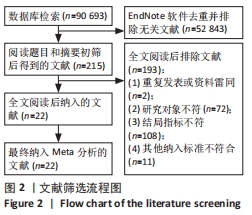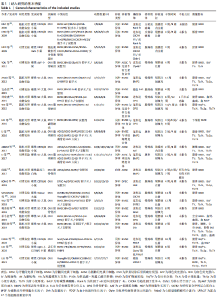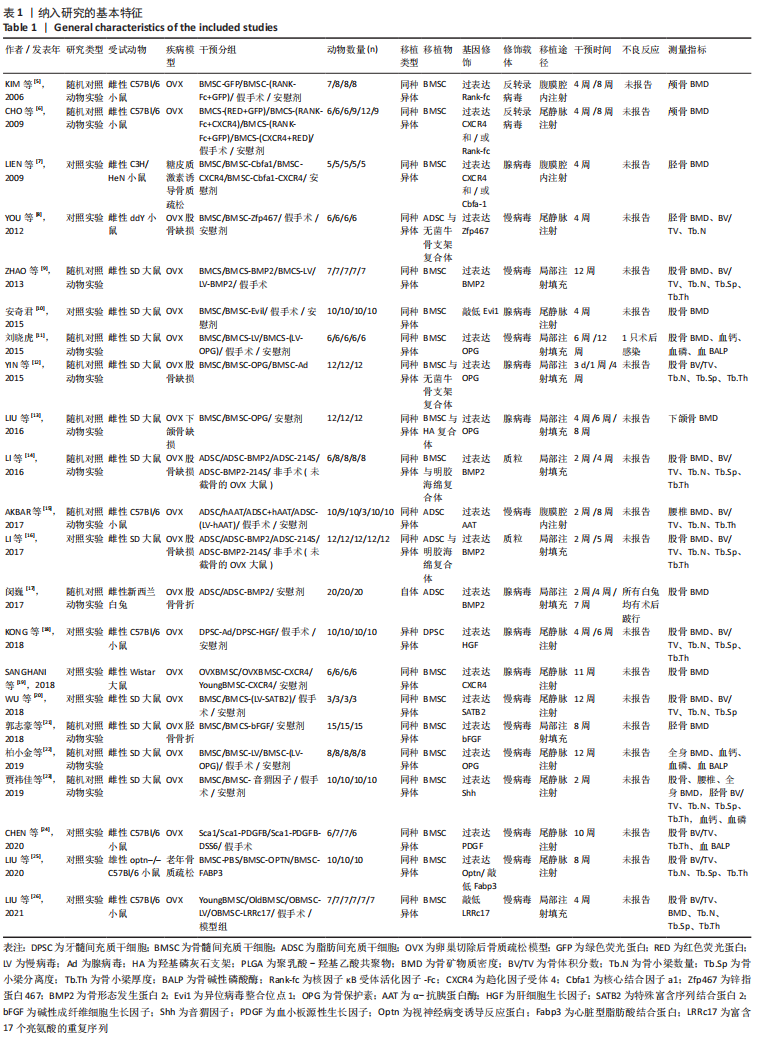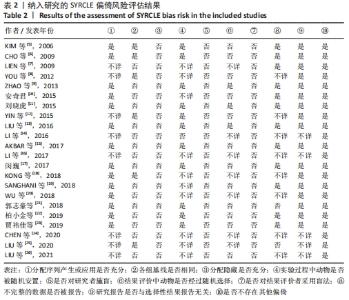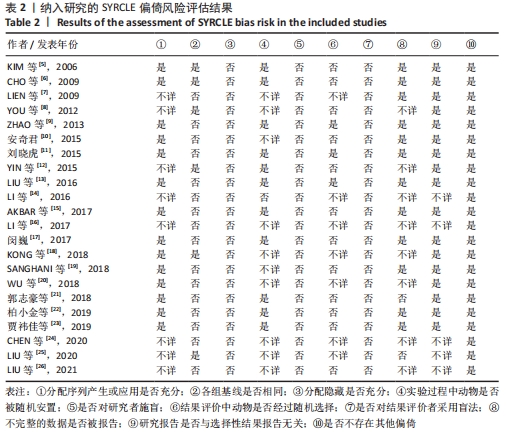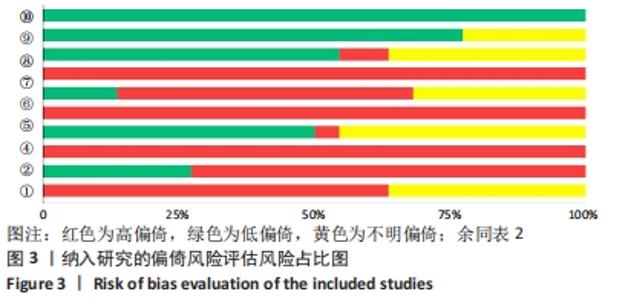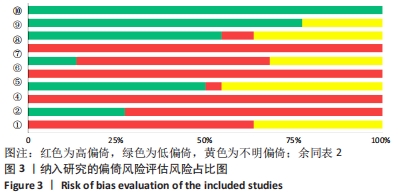Chinese Journal of Tissue Engineering Research ›› 2022, Vol. 26 ›› Issue (31): 5053-5061.doi: 10.12307/2022.734
Previous Articles Next Articles
Gene-modified stem cells therapy for osteoporosis: a meta-analysis of preclinical studies
Xiang Qianru1, Deng Xuejian1, Chen Huafeng1, Liang Jiamin1, An Min1, Yang Li1, 2
- 1Department of Endocrinology and Metabolism, 2Department of Nutrition, Zhujiang Hospital, Southern Medical University, Guangzhou 510220, Guangdong Province, China
-
Received:2021-10-25Accepted:2021-11-23Online:2022-11-08Published:2022-04-25 -
Contact:Yang Li, MD, Master’s supervisor, Associate professor, Associate chief physician, Department of Endocrinology and Metabolism, and Department of Nutrition, Zhujiang Hospital, Southern Medical University, Guangzhou 510220, Guangdong Province, China -
About author:Xiang Qianru, Master candidate, Department of Endocrinology and Metabolism, Zhujiang Hospital, Southern Medical University, Guangzhou 510220, Guangdong Province, China -
Supported by:the Natural Science Foundation of Guangdong Province, No. 2014A030310036 and No. 2018A030313609 (to YL); Clinical Research Nursery Project of Southern Medical University, No. LC2016YM007 (to YL)
CLC Number:
Cite this article
Xiang Qianru, Deng Xuejian, Chen Huafeng, Liang Jiamin, An Min, Yang Li. Gene-modified stem cells therapy for osteoporosis: a meta-analysis of preclinical studies[J]. Chinese Journal of Tissue Engineering Research, 2022, 26(31): 5053-5061.
share this article
Add to citation manager EndNote|Reference Manager|ProCite|BibTeX|RefWorks
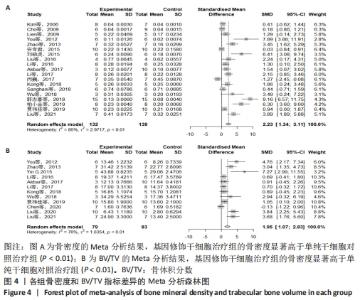
2.3 Meta分析结果 2.3.1 各组骨密度和BV/TV的差异 有19个研究报告了基因修饰干细胞相比于单纯干细胞对骨质疏松动物的骨密度的影响[5-11,13-23,26],各研究结果之间异质性较高(I2=85%,P < 0.01),选择随机效应模型,结果显示基因修饰干细胞组的骨密度明显高于单纯干细胞组(SMD=2.23,95%CI:1.34-3.11),见图4A。12个研究报告了基因修饰干细胞相比于单纯干细胞对骨质疏松动物的BV/TV的影响[8,9,12,14-16,18,20,23-26],各项研究结果之间有较高异质性(I2=76%,P < 0.01),选择随机效应模型,结果显示实验组的BV/TV高于对照组(SMD=1.95,95%CI:1.07-2.83),见图4B。"
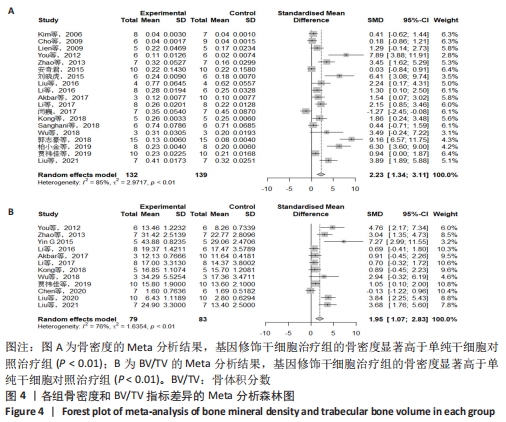
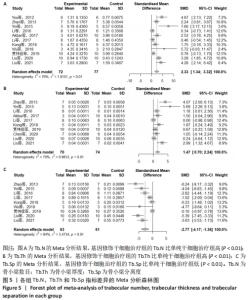
2.3.2 各组Tb.N、Tb.Th和Tb.Sp的差异 有11个研究报告了基因修饰干细胞相比于单纯干细胞对骨质疏松动物的Tb.N的影响[8-9,12,14-16,18,20,23,25-26],各项研究之间存在较高异质性(I2=76%,P < 0.01),选择随机效应模型,结果显示实验组的Tb.N高于对照组(SMD=2.33,95%CI:1.34-3.32),见图5A。有10个研究报告了基因修饰干细胞相比于单纯干细胞对骨质疏松动物的Tb.Th的影响[9,12,14-16,18,20,23,25,26],各项研究之间存在较高异质性(I2=70%,P < 0.01),选择随机效应模型,结果显示实验组的Tb.Th高于对照组(SMD=1.47,95%CI:0.70-2.24),见图5B。9个研究报告了基因修饰干细胞相比于单纯干细胞对骨质疏松动物的Tb.Sp的影响[9,12,14,16,18,20,23,25-26],各项研究之间存在较高异质性(I2=84%,P < 0.01),选择随机效应模型,结果显示实验组的Tb.Sp低于对照组(SMD=-2.77,95%CI:-4.17至-1.36),见图5C。"
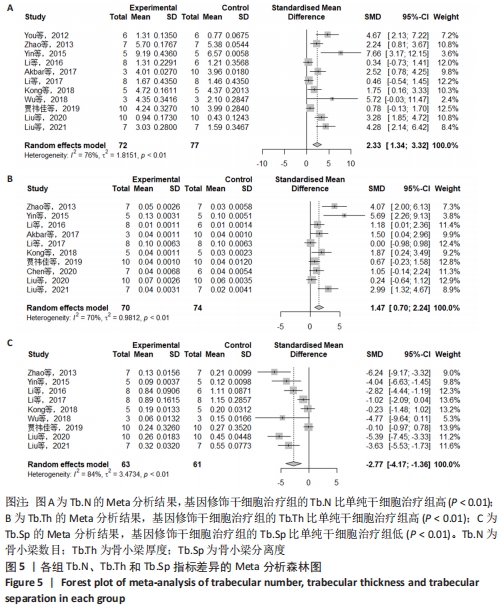
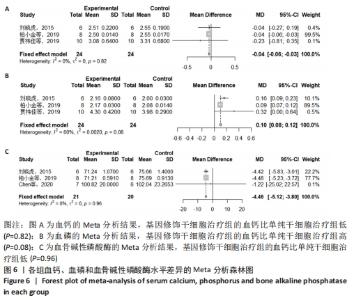
2.3.3 各组血钙、磷、骨碱性磷酸酶水平差异 有3个研究报告了基因修饰干细胞相比于单纯干细胞对骨质疏松动物的血钙的影响[11,22-23],各项研究无异质性(I2=0%,P=0.82),选择固定效应模型,结果显示实验组的血钙水平低于对照组(MD=-0.04,95%CI:-0.06至-0.03),见图6A。有3个研究报告了基因修饰干细胞相比于单纯干细胞对骨质疏松动物的血磷的影响[11,22-23],各项研究之间中度异质性(I2=60%),但差异无显著性意义(P=0.08),选择固定效应模型,结果显示实验组的血磷水平高于对照组(MD=0.10,95%CI:0.08-0.12),见图6B。3个研究报告了基因修饰干细胞相比于单纯干细胞对骨质疏松动物的血骨碱性磷酸酶的影响[11,22,24],各项研究无异质性(I2=0%,P=0.96),选择固定效应模型,结果显示实验组的血骨碱性磷酸酶水平低于对照组(MD=-4.46,95%CI:-5.12至-3.80),见图6C。"
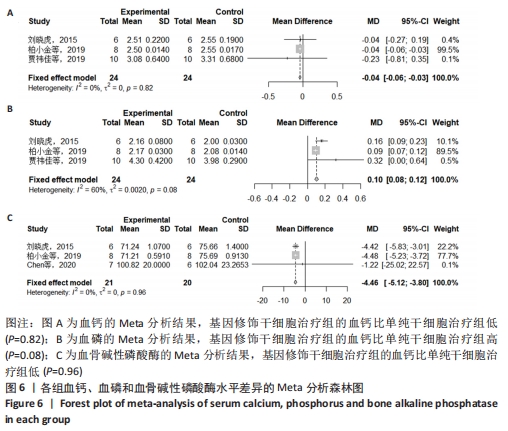
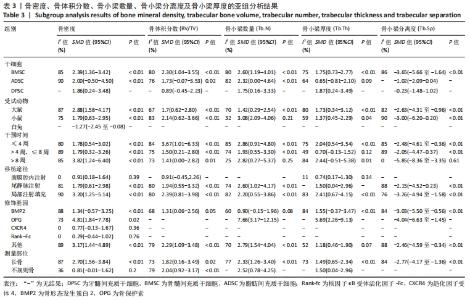
2.3.4 骨密度、BV/TV、Tb.N、Tb.Th和Tb.Sp的亚组分析结果 根据干细胞、受试动物、干预时间、移植途径、修饰基因和测量部位的不同对骨组织形态计量学指标骨密度、BV/TV、Tb.N、Tb.Th和Tb.Sp结局指标进行亚组分析,见表3。结果显示:①干细胞分为骨髓间充质干细胞、脂肪源性干细胞和牙髓源性干细胞组,脂肪源性干细胞亚组中实验组与对照组的Tb.Th没有显著差异(P=0.09);②受试动物分为大鼠、小鼠和白兔组,小鼠亚组中实验组的Tb.N高于对照组(P=0.21);③干预时间分为≤4周、> 4周≤8周和> 8周组,在> 8周亚组中实验组的Tb.Th高于对照组(P=0.25),Tb.Sp明显小于对照组(P=0.61),在> 4周≤8周亚组中实验组和对照组的Tb.Th无显著差异(P=0.12);④移植途径分为腹膜腔内注射、尾静脉注射和局部注射填充组,腹膜腔内注射亚组中实验组的骨密度高于对照组(P=0.39),Tb.Th高于对照组(P=0.34);⑤修饰基因分为骨形态发生蛋白2、骨保护素、Rank-Fc、CXCR4和其他,骨形态发生蛋白2亚组中实验组的BV/TV高于对照组(P=0.05),两组的Tb.Th无显著差异(P=0.08);CXCR4亚组和Rank-Fc亚组中实验组和对照组之间无异质性(I2=0%,P > 0.05),但两组的骨密度无显著差异,95%CI分别为(-0.13-1.67)和(-0.44-1.02);⑥测量部位分为长骨和不规则骨组,其中不规则骨亚组中实验组和对照组具有低度异质性(I2=0.2%,P=0.20),但两组骨密度无明显差异;⑦其余亚组中实验组和对照组之间异质性明显(P < 0.05),差异与总体趋势一致。"
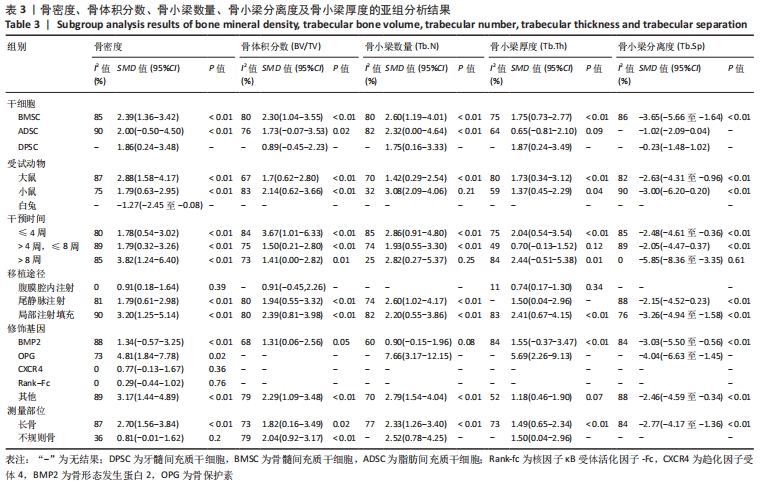
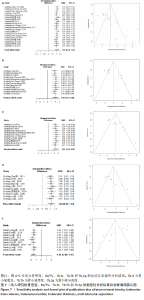
2.3.5 敏感性分析和发表偏倚分析结果 敏感性分析转换固定效应模型和随机效应模型对汇总效应量没有影响,逐一删除某个研究不会对合并效应量结果产生影响。除BV/TV分析的漏斗图基本对称之外,其余均存在一定的发表偏倚。血钙分析中纳入3个研究,Egger检测结果显示:t=-0.96,P=0.512 2,不存在发表偏倚;血磷分析中纳入3个研究,Egger检测结果显示:t=3.03,P=0.202 8,不存在发表偏倚;血骨碱性磷酸酶水平分析中纳入3个研究,Egger检测结果显示:t=-1.10,P=0.385 5,不存在发表偏倚。骨密度、BV/TV、Tb.N、Tb.Th、Tb.Sp的敏感性分析和发表偏倚漏斗图见图7。"
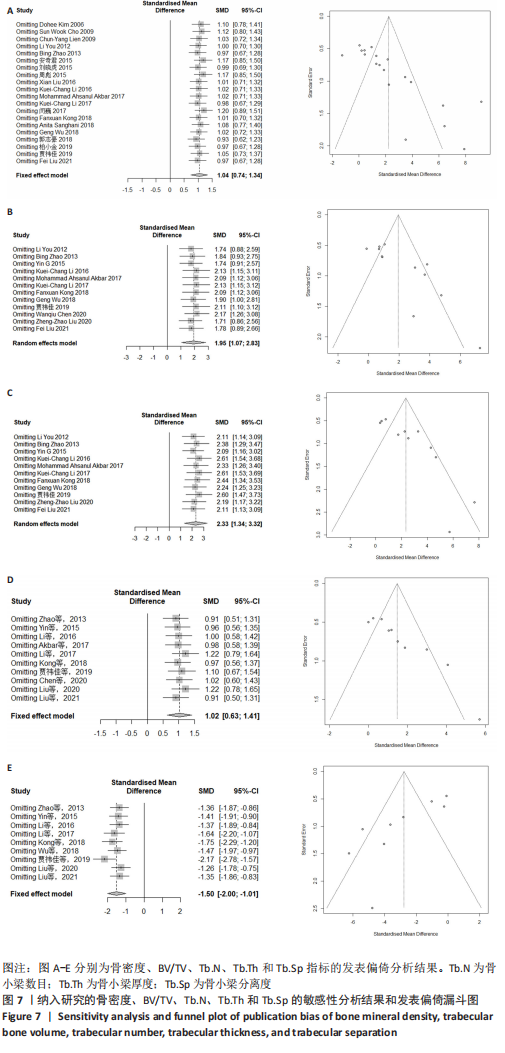
| [1] 白璧辉,谢兴文,李鼎鹏,等.我国近5年来骨质疏松症流行病学研究现状[J].中国骨质疏松杂志,2018,24(2):253-258. [2] XIONG Z, YI P, LIN J, et al. Evaluation of the efficacy of stem cell therapy in ovariectomized osteoporotic rats based on micro-ct and dual-energy x-ray absorptiometry: a systematic review and meta-analysis. Stem Cells Int. 2021;2021:1439563. [3] JIANG Y, ZHANG P, ZHANG X, et al. Advances in mesenchymal stem cell transplantation for the treatment of osteoporosis. Cell Prolif. 2021;54(1):e12956. [4] HOOIJMANS CR, ROVERS MM, de VRIES RB, et al. SYRCLE’s risk of bias tool for animal studies. BMC Med Res Methodol. 2014;14:43. [5] KIM D, CHO SW, HER SJ, et al. Retrovirus-mediated gene transfer of receptor activator of nuclear factor-kappaB-Fc prevents bone loss in ovariectomized mice. Stem Cells. 2006;24(7):1798-1805. [6] CHO SW, SUN HJ, YANG JY, et al. Transplantation of mesenchymal stem cells overexpressing RANK-Fc or CXCR4 prevents bone loss in ovariectomized mice. Mol Ther. 2009;17(11):1979-1987. [7] LIEN CY, CHIH-YUAN HK, LEE OK, et al. Restoration of bone mass and strength in glucocorticoid-treated mice by systemic transplantation of CXCR4 and cbfa-1 co-expressing mesenchymal stem cells. J Bone Miner Res. 2009;24(5):837-848. [8] YOU L, PAN L, CHEN L, et al. Suppression of zinc finger protein 467 alleviates osteoporosis through promoting differentiation of adipose derived stem cells to osteoblasts. J Transl Med. 2012;10:11. [9] ZHAO B, WANG Q, TAO T, et al. The in vitro and in vivo treatment effects of overexpressed lentiviral vector-mediated human BMP2 gene in the femoral bone marrow stromal cells of osteoporotic rats. Int J Mol Med. 2013;32(6):1355-1365. [10] 安奇君.抑制Evi1基因表达促进BMSCs成骨分化治疗骨质疏松症的研究[D].太原:山西医科大学,2015. [11] 刘晓虎.携带OPG基因的慢病毒转染骨髓间充质干细胞治疗骨质疏松大鼠的效果研究[D].太原:山西医科大学,2015. [12] YIN G, CHEN J, WEI S, et al. Adenoviral vector-mediated overexpression of osteoprotegerin accelerates osteointegration of titanium implants in ovariectomized rats. Gene Ther. 2015;22(8): 636-644. [13] LIU X, BAO C, XU H, et al. Osteoprotegerin gene-modified BMSCs with hydroxyapatite scaffold for treating critical-sized mandibular defects in ovariectomized osteoporotic rats. Acta Biomater. 2016;42:378-388. [14] LI KC, CHANG Y H, YEH CL, et al. Healing of osteoporotic bone defects by baculovirus-engineered bone marrow-derived MSCs expressing microRNA sponges. Biomaterials. 2016;74:155-166. [15] AKBAR MA, LU Y, ELSHIKHA AS, et al. Transplantation of adipose tissue-derived mesenchymal stem cell (ATMSC) expressing alpha-1 antitrypsin reduces bone loss in ovariectomized osteoporosis mice. Hum Gene Ther. 2017;28(2):179-189. [16] LI KC, CHANG YH, HSU MN, et al. Baculovirus-mediated mir-214 knockdown shifts osteoporotic ASCs differentiation and improves osteoporotic bone defects repair. Sci Rep. 2017;7(1):16225. [17] 闵巍.腺病毒介导hBMP-2转染ADSCs治疗兔骨质疏松性骨折的实验研究[D].遵义:遵义医学院,2017. [18] KONG F, SHI X, XIAO F, et al. Transplantation of hepatocyte growth factor-modified dental pulp stem cells prevents bone loss in the early phase of ovariectomy-induced osteoporosis. Hum Gene Ther. 2018;29(2): 271-282. [19] SANGHANI A, OSAGIE-CLOUARD L, SAMIZADEH S, et al. CXCR4 has the potential to enhance bone formation in osteopenic rats. Tissue Eng Part A. 2018;24(23-24): 1775-1783. [20] WU G, XU R, ZHANG P, et al. Estrogen regulates stemness and senescence of bone marrow stromal cells to prevent osteoporosis via ERbeta-SATB2 pathway. J Cell Physiol. 2018;233(5):4194-4204. [21] 郭志豪,刘晓潭,刘槃,等.骨髓间充质干细胞过表达碱性成纤维细胞生长因子对骨质疏松性骨折大鼠的治疗作用[J].中华实验外科杂志,2018,35(3):505-508. [22] 柏小金,黄文良,柏帆,等.骨保护素基因修饰的骨髓间充质干细胞治疗大鼠骨质疏松[J].中国老年学杂志,2019,39(13): 3245-3249. [23] 贾祎佳,罗春山,陆廷盛,等.音猬因子修饰的骨髓间充质干细胞治疗大鼠骨质疏松的实验研究[J].中华老年骨科与康复电子杂志,2019,5(4):211-216. [24] CHEN W, WASNIK S, FU Y, et al. Unique anabolic action of stem cell gene therapy overexpressing PDGFB-DSS6 fusion protein in OVX osteoporosis mouse model. Bone Rep. 2020;12:100236. [25] LIU ZZ, HONG CG, HU WB, et al. Autophagy receptor OPTN (optineurin) regulates mesenchymal stem cell fate and bone-fat balance during aging by clearing FABP3. Autophagy. 2020;17(10):2766-2782. [26] LIU F, YUAN Y, BAI L, et al. LRRc17 controls BMSC senescence via mitophagy and inhibits the therapeutic effect of BMSCs on ovariectomy-induced bone loss. Redox Biol. 2021;43:101963. [27] BENISCH P, SCHILLING T, KLEIN-HITPASS L, et al. The transcriptional profile of mesenchymal stem cell populations in primary osteoporosis is distinct and shows overexpression of osteogenic inhibitors. PLoS One. 2012;7(9):e45142. [28] XIA L, XU Y, CHANG Q, et al. Maxillary sinus floor elevation using BMP-2 and Nell-1 gene-modified bone marrow stromal cells and TCP in rabbits. Calcif Tissue Int. 2011; 89(1):53-64. [29] LIU X, BAO C, XU H, et al. Osteoprotegerin gene-modified BMSCs with hydroxyapatite scaffold for treating critical-sized mandibular defects in ovariectomized osteoporotic rats. Acta Biomater. 2016;42: 378-388. [30] BOBIS-WOZOWICZ S, MIEKUS K, WYBIERALSKA E, et al. Genetically modified adipose tissue-derived mesenchymal stem cells overexpressing CXCR4 display increased motility, invasiveness, and homing to bone marrow of NOD/SCID mice. Exp Hematol. 2011;39(6):686-696. [31] 张雪丽,汤光宇.影像新技术在骨质疏松疗效评估中的研究进展[J].国际医学放射学杂志,2017,40(5):547-551. [32] 李建赤,黄必留,徐自强.骨组织形态计量学在临床骨病应用中的研究与进展[J].中国组织工程研究与临床康复,2011, 15(35):6607-6610. [33] 伍金秋,钟清.血清碱性磷酸酶在慢性肾脏病矿物质和骨代谢紊乱发生发展中作用的研究进展[J].山东医药,2018,58(21): 102-105. [34] WALMSLEY G G, RANSOM R C, ZIELINS E R, et al. Stem cells in bone regeneration. Stem Cell Rev Rep. 2016;12(5):524-529. [35] 游斌,黄秀珠,林煜,等.自然衰老大鼠不同部位骨组织形态、骨密度及骨代谢指标的变化[J].中国组织工程研究,2021, 25(26):4118-4122. |
| [1] | Zhu Chan, Han Xuke, Yao Chengjiao, Zhou Qian, Zhang Qiang, Chen Qiu. Human salivary components and osteoporosis/osteopenia [J]. Chinese Journal of Tissue Engineering Research, 2022, 26(9): 1439-1444. |
| [2] | Jing Jinpeng, Zhang Yue, Liu Xiaomin, Liu Yi. Traditional Chinese medicine injection for promoting blood circulation in prevention of deep vein thrombosis after orthopedic surgery: network meta-analysis [J]. Chinese Journal of Tissue Engineering Research, 2022, 26(9): 1467-1476. |
| [3] | Jiang Huanchang, Zhang Zhaofei, Liang De, Jiang Xiaobing, Yang Xiaodong, Liu Zhixiang. Comparison of advantages between unilateral multidirectional curved and straight vertebroplasty in the treatment of thoracolumbar osteoporotic vertebral compression fracture [J]. Chinese Journal of Tissue Engineering Research, 2022, 26(9): 1407-1411. |
| [4] | Kong Yamin, Yan Juntao, Ma Bingxiang, Li Huawei. Massage vibration intervenes with MyoD expression and proliferation and differentiation of muscle satellite cells in rats with sciatic nerve injury [J]. Chinese Journal of Tissue Engineering Research, 2022, 26(8): 1160-1166. |
| [5] | Li Wei, Zhu Hanmin, Wang Xin, Gao Xue, Cui Jing, Liu Yuxin, Huang Shuming. Effect of Zuogui Wan on bone morphogenetic protein 2 signaling pathway in ovariectomized osteoporosis mice [J]. Chinese Journal of Tissue Engineering Research, 2022, 26(8): 1173-1179. |
| [6] | Wang Jing, Xiong Shan, Cao Jin, Feng Linwei, Wang Xin. Role and mechanism of interleukin-3 in bone metabolism [J]. Chinese Journal of Tissue Engineering Research, 2022, 26(8): 1260-1265. |
| [7] | Xiao Hao, Liu Jing, Zhou Jun. Research progress of pulsed electromagnetic field in the treatment of postmenopausal osteoporosis [J]. Chinese Journal of Tissue Engineering Research, 2022, 26(8): 1266-1271. |
| [8] | Liu Gang, Ma Chao, Wang Le, Zeng Jie, Jiao Yong, Zhao Yi, Ren Jingpei, Hu Chuanyu, Xu Lin, Mu Xiaohong. Ankle-foot orthoses improve motor function of children with cerebral palsy: a Meta-analysis based on 12 randomized controlled trials [J]. Chinese Journal of Tissue Engineering Research, 2022, 26(8): 1299-1304. |
| [9] | Tian Chuan, Zhu Xiangqing, Yang Zailing, Yan Donghai, Li Ye, Wang Yanying, Yang Yukun, He Jie, Lü Guanke, Cai Xuemin, Shu Liping, He Zhixu, Pan Xinghua. Bone marrow mesenchymal stem cells regulate ovarian aging in macaques [J]. Chinese Journal of Tissue Engineering Research, 2022, 26(7): 985-991. |
| [10] | Gao Yujin, Peng Shuanglin, Ma Zhichao, Lu Shi, Cao Huayue, Wang Lang, Xiao Jingang. Osteogenic ability of adipose stem cells in diabetic osteoporosis mice [J]. Chinese Journal of Tissue Engineering Research, 2022, 26(7): 999-1004. |
| [11] | Huang Chenwei, Fei Yankang, Zhu Mengmei, Li Penghao, Yu Bing. Important role of glutathione in stemness and regulation of stem cells [J]. Chinese Journal of Tissue Engineering Research, 2022, 26(7): 1119-1124. |
| [12] | Hui Xiaoshan, Bai Jing, Zhou Siyuan, Wang Jie, Zhang Jinsheng, He Qingyong, Meng Peipei. Theoretical mechanism of traditional Chinese medicine theory on stem cell induced differentiation [J]. Chinese Journal of Tissue Engineering Research, 2022, 26(7): 1125-1129. |
| [13] | An Weizheng, He Xiao, Ren Shuai, Liu Jianyu. Potential of muscle-derived stem cells in peripheral nerve regeneration [J]. Chinese Journal of Tissue Engineering Research, 2022, 26(7): 1130-1136. |
| [14] | Fan Yiming, Liu Fangyu, Zhang Hongyu, Li Shuai, Wang Yansong. Serial questions about endogenous neural stem cell response in the ependymal zone after spinal cord injury [J]. Chinese Journal of Tissue Engineering Research, 2022, 26(7): 1137-1142. |
| [15] | Guo Jia, Ding Qionghua, Liu Ze, Lü Siyi, Zhou Quancheng, Gao Yuhua, Bai Chunyu. Biological characteristics and immunoregulation of exosomes derived from mesenchymal stem cells [J]. Chinese Journal of Tissue Engineering Research, 2022, 26(7): 1093-1101. |
| Viewed | ||||||
|
Full text |
|
|||||
|
Abstract |
|
|||||
